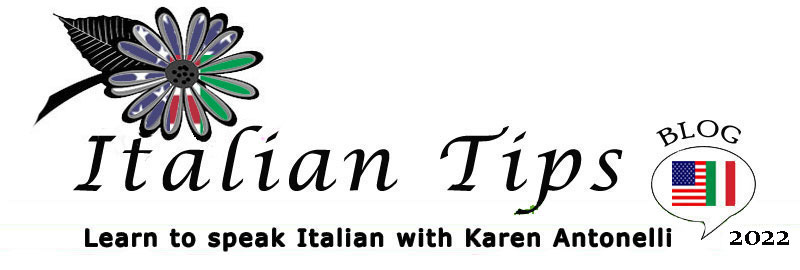|
|
|
|
|
|
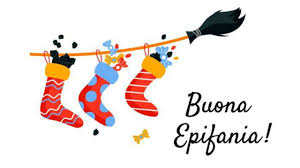 2023 2023
La festa dell’Epifania, si celebra il 6 gennaio in tutta Italia, è una festa
tradizionale molto sentita e rappresenta la coda finale delle celebrazioni
natalizie italiane. Con l’Epifania si commemora il 12° giorno dal Natale
quando i tre Re Magi arrivarono alla mangiatoia portando con loro dei
doni per Gesù bambino. Si dice che “l’epifania tutte le feste porta via,
” infatti le vacanze natalizie si interrompono proprio questo giorno.
In Italia i bambini sono soliti mettere delle calze vuote fuori dalla porta
della propria camera o vicino alle finestre in attesa che la Befana arrivi e
le riempia di dolciumi e frutta.
La leggenda della Befana
Secondo la leggenda, la notte prima che i tre Re Magi arrivassero alla
mangiatoia si fermarono presso la capanna di una vecchia donna a
chiedere indicazioni. La invitarono a farsi avanti ed unirsi a loro, ma lei
rispose che era troppo occupata. Un pastore poi le chiese di unirsi a lui,
ma ancora una volta lei si rifiutò. Più tardi quella notte, vide una grande
luce nel cielo e decise così di unirsi ai Re Magi e ai pastori per portare dei
doni a Gesù bambino. Purtroppo la leggenda vuole che la Befana si sia
persa nella notte e non sia mai riuscita a portare i suoi doni.
Per questo motivo ora vola in giro sulla sua scopa ogni anno, nella notte
del5 gennaio, portando doni ai bambini nella speranza di poter trovare
Gesùbambino.
Vi auguro anche un BUON ANNO, e UN 2023 PIENO DI SALUTE E
GIOIA.
The feast of the Epiphany is celebrated throughout Italy on January 6th;
it represents the final celebration of the Christmas season.
The epiphany commemorates the 12th day of Christmas when the Three
Wise Men arrived at the manger to present their gifts to the baby Jesus.
The proverb states (in true Italian rhyming fashion) “The Epiphany takes
away all of the holidays” since this is the end of the Christmas season.
Throughout Italy, children usually place empty stockings outside the door
oftheir bedroom or close to a window, hoping that the Befana comes and
fillsthem with sweets and fruit.
The legend of the Befana
According to legend, the night before the Three Magi arrived at the
manger, they stopped by the shack of an old woman to ask for directions.
The invited her to join them, but she answered that she was too busy. A
shepherd subsequently asked her to join him, but angina she refused.
Later that night, she saw a great light in the sky and then decided to join
the Magi and the shepherds in order to bring her gifts to the baby Jesus.
Unfortunately, the legend states that the Befana got lost during the night
and was unable todeliver her gifts.
For this reason she flies around on her broom every year during the night
of January 5th, bringing gifts to children in the hope to be able to find the
baby Jesus.
For now, I wish you A HAPPY NEW YEAR and A 2023 FILLED WITH
HEALTH AND JOY.
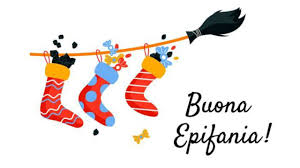
Saturday, Decenber 31, 2022
|
|
|
TRAMITE LE PAROLE DELL’UNICO, DELL’ECCEZIONALE GIANNI
RODARI, AUGURO A TUTTI UN BUON NATALE

THROUGH THE WORDS OF THE ONE AND ONLY GIANNI RODARI,
I WISH YOU ALL A 
If we give each other a hand, miracles will happen, and Christmas day
will last all year long.
Saturday, Decenber 17, 2022
|
|
I NOMI COLLETTIVI usano il verbo al singolare o al plurale?
I nomi collettivi—quelli che indicano un insieme di cose, animali, e
persone—usano il verbo al singolare.
Per esempio:
1. Gruppi di persone: comitiva, famiglia, folla, gente, gruppo, polizia,
pubblico, ecc.
La polizia è arrivata in tempo e ha arrestato il ladro.
2. Gruppi di animali: gregge, mandria, nugolo, sciame, ecc.
Uno sciame di api ci ha attaccato al parco.
3. Gruppi di cose: costellazione, flotta, fogliame, serie, ecc.
La flotta di navi è entrata in porto.
4. I numerali che si riferiscono a una somma di più persone o cose
concepite come un’unità:
coppia, dozzina, duetto, moltitudine, paio, trentina, ecc.
Il duetto ha suonato benissimo ieri sera.
ATTENTI: se il nome collettivo è seguito dalla preposizione “di” si può
usare sia il verbo al singolare (per la concordanza grammaticale) sia il
verbo al plurale (per la concordanza a senso).
Alla partita, un migliaio di persone è saltato in piedi quando gli
Azzurri hanno segnato il primo gol.
Alla partita, un migliaio di persone sono saltate in piedi quando
gli Azzurri hanno segnato il primo gol.
NEL PARLATO: con i nomi collettivi che indicano quantità è frequente
l’uso del verbo al plurale.
Un sacco di studenti sono andati in sciopero.
Do COLLECTIVE NOUNS use a singular or plural verb?
Collective nouns—the ones that refer to a union of things, animals, and
persons—take a singular verb.
For example:
1. Groups of persons: committees, families, crowds, people, groups,
police, public, etc.
The police arrived in time and arrested the thief.
2. Groups of animals: flocks, herds, whole hosts of, swarms, etc.
A swarm of bees attacked us at the park.
3. Groups of things: constellations, fleet, foliage, series, etc.
The fleet of ships entered the port.
4. Numbers that refer to a total of more than one person or things
thought of as a whole: couple,
dozen, duet, multitude, pair, thirty, etc.
The duet played very well yesterday evening.
BE CAREFUL: if the collective noun is followed by the preposition “di” the
verb can be either singular (for grammatical agreement) or plural (for the
sense of the phrase).
At the game, a thousand people jumped up when the Azzurri [the
Italian national team] scored the first goal.
At the game, a thousand people jumped up when the Azzurri
scored the first goal.
WHEN SPOKEN: collective nouns that indicate quantities, the verb is
frequently used in the plural.
A bunch of students went on strike.
Saturday, Decenber 3, 2022
|
|

Thanksgiving is a federal holiday in the United States, celebrated on the
fourth Thursday of November. After a request by Congress, George
Washington, proclaimed the celebration of the first Thanksgiving
nationally in 1789. Thomas Jefferson chose not to observe the holiday,
and its celebration was intermittent until the presidency of Abraham
Lincoln, when Thanksgiving became a federal holiday in 1863, during the
American Civil War to be celebrated on the last Thursday in November.
Under President Franklin D. Roosevelt, the date changed between 1939
and 1941. Finally, in 1942 Congress proclaimed it to fall on the fourth
Thursday in November. Thanksgiving marks the beginning of the
fall–winter holiday season, which, of course, includes Christmas,
Hanukah,Kwanzaa, and New Year’s celebrations.
  TO ALL / A TUTTI TO ALL / A TUTTI
Thanksgiving, il Giorno di ringraziamento, o più semplicemente "il
Ringraziamento", è una festa nazionale celebrata il quarto giovedì di
novembre. Sotto richiesta del Congresso, George Washinton, proclamò
la celebrazione del primo Thanksgiving nazionale nel 1789. Thomas
Jefferson scelse di non osservare la festa, e questa celebrazione fu
intermittente fino alla presidenza di Abraham Lincoln, quando
Thanksgiving divenne una festa nazionale da essere celebrata l’ultimo
giovedì di novembre, nel 1863, durante la Guerra Civile Americana. Sotto
il presidente Franklin D. Roosevelt, la data cambiò tra il 1939 e il 1942.
Finalmente, nel 1942 il Congresso proclamò che Thanksgiving fosse il
quarto giovedì di novembre. Thanksgiving marca l’inizio della stagione
festiva autunno-invernale, che include Natale, Hanukkah, Kwanza, e
Capo d’Anno.

Saturday, November 19, 2022
|
|
LE DITA DEL PIEDE 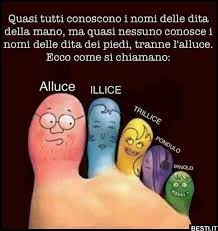
Nella terminologia anatomica internazionale, grazie al latino, i
nomi delle dita del piede sono:
Digitus primus o Hallux [I]
Digitus secundus [II]
Digitus tertius [III]
Digitus quartus [IV]
Digitus quintus o minimus [V]
Mentre, come vediamo nel disegno, le dita del piede, nel
linguaggio comune sono:
Alluce o pollicione
Illice o Melluce o, più comunemente, secondo dito del piede
Trillice o Trilluce o, più comunemente, terzo dito del piede
Pondolo o Pondulo o Anulo o, più comunemente, quarto dito del
piede
Minolo o Mellino o Mignolino del piede o, più comunemente,
quinto dito del piede.
 
NAMES OF THE TOES:
The first toe / hallux / big toe / great toe / the piggy that went to
market
The second toe / index toe / long toe / pointer toe / the piggy that
stayed home
The third toe / middle toe / the piggy that ate roast beef
The fourth toe / ring toe / the piggy that had none
The fifth toe / baby toe / little toe / pinky toe / small toe / tiny toe
/ the piggy that went wee, wee, wee, all the way home!
Whereas, the international anatomic terminology is from the Latin
(see above).
Saturday, November 5, 2022
|
|

LE DITA DELLA MANO
La filastrocca della mano è usata per insegnare ai bambini i nomi
delle dita della mano:
Pollice è il più bello, Indice è monello, Medio è lungo lungo,
L’anulare fa da fungo al Mignolino, che di tutti è il più piccino.
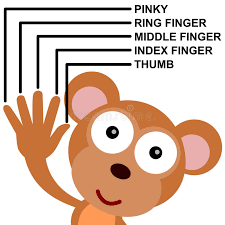
THE FINGERS OF THE HAND
In Italy, a nursery rhyme is used to help children learn the names of
the fingers. It is loosely translated as follows (please remember
that it is impossible to translate both rhyme and meaning from one
language toanother):
The thumb is the most beautiful,
The index is a rascal,
The middle is very long,
The ring finger acts as a mushroom cap to
The pinky, which is the smallest of them all.
Saturday, October 22, 2022
|
|
Egregio = Egregious? NO, state attenti!
Se vi arriva una lettera dall’Italia intestata a: “Egregio Signore” o “Egregia
Dottoressa” non è un insulto! È l’equivalente in inglese a “Dear Sir/Madam”.
Secondo il dizionario Treccani, l’aggettivo egregio <<deriva dal latino
egregius “che esce dal gregge”, era il titolo dei funzionari romani
dell’ordine equestre. Significa una persona che esce dall’ordinario, che ha
pregi singolari, insigne, eccellente. Si adopera specialmente negli indirizzi
e nelle intestazioni delle lettere.>>
Egregio non si traduce a “egregious” in inglese. Se vogliamo descrivere
una situazione offensiva, diciamo “oltraggiosa” o “vergognosa”.
 
Egregio = Egregious? NO, be careful!
If you receive a letter from Italy addressed to “Egregio Signore” or “Egreg
ia Dottoressa” it’s not an insult! It is the equivalent of “Dear Sir/Madam”.
According to the Treccani dictionary, the adjectiveegregio “derives from
the Latin egregius ‘one who leaves the herd or the flock’, it was the title
given to Roman officials of the equestrian order. It describes a person
who is out of the ordinary, who has unique qualities, is eminent, excellent.
It is used for the most part in addresses or letterheads.”
‘Egregio’ does not translate as ‘egregious’ into English. If we want to
describe an offensive, egregious situation in Italian, say “oltraggiosa” or
“vergognosa”.
Saturday, October 8, 2022
|
|
| |
Il verbo "VENIRE", espressioni idiomatiche—
Parte 2
Divertiamoci mentre impariamo delle nuove espressioni con questo verbo
irregolare ma molto usato:
• venire alle mani → accapigliarsi, azzuffarsi: Romolo e Remo si insultano
di continuo, hanno litigato e finalmente sono venuti alle mani.
• venire in possesso → impossessarsi: Il collezionista venne in possesso
del capolavoro che era stato rubato dal museo nazionale; ma la polizia
ricevette una soffiata e recuperò il quadro.
• venire incontro a qualcuno → cercare di soddisfare le esigenze di
qualcuno: I due compagni di casa hanno programmi molto diversi ma hanno
fatto del tutto per venirsi incontro e adesso vanno d’accordo.
• venirne fuori → riuscire a superare una situazione particolarmente grave
o dolorosa: Dopo il divorzio e il rifiuto da parte di suo figlio, Adele ha
passato un brutto periodo, ma è riuscita a venirne fuori.
• venirsene fuori → dire inaspettatamente qualcosa che in genere si rivela
sciocco o inopportuno: I due fidanzati stavamo parlando tranquillamente
quando lui se ne è venuto fuori con il nome di un’altra donna.
• venir su → crescere, svilupparsi:
1. Massimo e Davide sono amici dall’asilo, sono venuti su insieme.
(= sono cresciuti insieme),
 2. Il giardiniere ha usato fertilizzanti organici nel giardino, e ora le 2. Il giardiniere ha usato fertilizzanti organici nel giardino, e ora le
piante vengono su rigogliose (= crescono lussureggianti);
• non mi viene (in mente) → non riesco a ricordarlo: Riconosco quella
signora, era una mia insegnante delle medie, ma non mi viene il nome.
The verb “TO COME” idiomatic expressions—Part 2

Let’s have some fun while we learn some new expressions with this irregular,
but commonly used, verb.
· Come to blows (hands): to fight, to wrangle: Romulus and Remus
insulted each other constantly, they fought and finally they came to blows.
· Come into possession of: to take possession of: The collector
came into possession of the masterpiece that was stolen from the national
museum; but the police received a tip and were able to recover the painting.
· Come towards someone: (meet part way) try to satisfy the needs of
another: The two housemates have very different schedules, but they did
everything possible to meet in the middle, and now they get along.
· Come out: to be able to overcome a particularly difficult or painful
situation: After the divorce and her son’s rejection, Adele went through a
difficult period but she was able to come out of it.
· Come/blurt out: unexpectedly say something that is silly or
inappropriate: The two lovers were speaking calmly when he blurted out the
name of another woman.
· Come up:
1. To grow up or develop: Maximilian and David have known each
other since kindergarten they grew up together.
2. To grow or flourish: The gardener used organic fertilizer in the
garden and now the plants are flourishing.
· It does not come (to mind): unable to remember. I recognize that
woman, she was one of my middle school teachers, but her name just does
not come to mind.
Saturday, September 24, 2022
|
|
Il verbo "VENIRE", espressioni idiomatiche
—Parte 1
Divertiamoci mentre impariamo delle nuove espressioni con questo verbo
irregolare ma molto usato:
• venire a capo di qualcosa → giungere a un esito, a una conclusione, trovare
una soluzione, risolvere: L’associazione del vicinato ha cercato di risolvere il
problema dell’inquilino indelicato, ma non ne è venuta a capo.
• venire a noia → cominciare ad annoiare: Giovanni mi ha raccontato la stessa
storia così tante volte che ormai mi è venuta a noia.
• venire (anche: scendere) a patti con qualcuno, con qualcosa → accordarsi,
accettare un compromesso, riconciliarsi: Oggigiorno non è facile venire a patti
con le nazioni che sono in guerra, ciascuna rifiuta ogni compromesso, essendo
sicura di essere nel giusto.
• venire a sapere qualcosa, venire a conoscenza di qualcosa → essere
informato di qualcosa: Tramite un post su Facebook, sono appena venuta a
sapere che il fidanzato di Irene ha sposato un’altra.
• venire al dunque (anche: arrivare al dunque) → arrivare al punto essenziale
di una questione: Ti prego di venire al dunque, è più di un’ora che meni il can
per l’aia, cosa vuoi da me?
• venire alla luce →
1. Nascere (o: venire al mondo): Mia nipote ha avuto un secondo
figlio, è venuto alla luce ad aprile, si chiama Marco, e ovviamente è bellissimo!
2. Se si parla di scavi o opere simili significa "ricomparire": Durante gli
scavi per la metropolitana a Roma, sono venuti alla luce tesori archeologici e
antichi monumenti.
3. Se si parla di fatti e circostanze significa "emergere": Durante la più
recente riunione del Consiglio d’amministrazione della fabbrica, sono venute alla
luce delle discrepanze finanziarie allarmanti.

The verb “TO COME” idiomatic expressions
—Part 1
Let’s have some fun while we learn some new expressions with this irregular,
but commonly used, verb.
· Come to the head of something: reach an outcome or a conclusion; find a
solution; resolve: The homeowners association tried to find a solution to the
problem of the rude tenant, but it could not come to terms and resolve the
situation.
· Come to boredom: begin to bore: John has told me the same story so
many times that now it bores me no end.
· Come (even get down) to terms with someone or something: to agree;
reach a compromise; reconcile. These days it is not easy for warring nations to
come to terms; each one refuses any compromise, sure to be in the right.
· Come to know; to learn about: to be informed about something. By
means of a Facebook post, I just learned that Irene’s fiancé married someone
else.
· Get to the point: arrive to the essential point of a question. I beg you,
get to the point; it’s more than an hour that you are beating around the bush.
· Come to light:
1. To be born (to come into this world). My niece had her second son,
he came into this world in April, his name is Marco, and obviously, he is
gorgeous!
2. If we talk about digs or other similar works, it means to “reappear”.
During the digs for the subway in Rome, archeological treasures and ancient
monuments came to light.
3. If we talk about facts or circumstances, it means to “emerge”. During
the most recent meeting of the Board of Directors of the factory, alarming
financial discrepancies came to light.
Saturday, September 10, 2022
|
|
Quando si usa NO o NON?
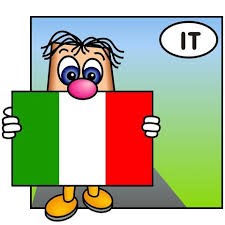
NO si usa:
1. Quando è il contrario di sì. Avete conosciuto la nuova
studentessa? No, ma sappiamo che si chiama Chiara.
2. In una domanda, per non ripetere la frase, con valore
riassuntivo. Marco ti piacerebbe visitare Pescara o no? (Marco, ti
piacerebbe o non ti piacerebbe visitare Pescara?)
3. In esclamazioni per indicare sorpresa (quando viene
scritto di solito si vede con più di una “o”, per allungare il suono
della vocale. Avete sentito che il nuovo pop star ha avuto un
incidente automobilistico ed è stato ricoverato in ospedale? Noo,
cosa è successo?
NON si usa:
1. Per rendere negativa una frase. Massimiliano non mangia la
carne, è vegetariano.
2. Per formare l’imperativo negativo. Bambini, vi prego, non gridate,
papà ha un’emicrania.
3. In frasi con la doppia negazione. Quando è arrivato al processo, il
testimone ha cambiato storia dicendo di non avere sentito niente,
non aver visto nessuno, e che non era mai stato in quel locale. Che
disastro!
NO e NON si possono usare insieme per dare enfasi a una
risposta negativa. Vi va di affittare una villetta al mare per una
settimana quest’estate? No, non possiamo proprio, i nostri
risparmi sono a zero.
When do we use NO or “NON”?
NO is used:
1. when it is the opposite of yes. Have you met the new student?
No, but we know her name is Claire.
2. in a question, so as not to repeat the phrase; it has a
reiterative use. Marco, would you like to visit Pescara or not?
(Would you like to or not like to visit Pescara?)
3. in exclamations to indicate surprise. (When it is written, an “o”
is added to elongate the vowel. Did you hear that the new pop
star had a car accident and was admitted to the hospital? Noo,
what happened?
NON is used:
1. to make a sentence negative. Max does not eat meat; he is
a vegetarian.
2. to form the negative of the imperative. Children, please, don’t
yell, daddy has a migraine.
3. in sentences with double negatives. When it came tothe trial,
the witness changed his story saying that he had not heard
anything, that he had not seen anything, and that he had
never been in that place. What a disaster!
NO and NON can be used together to further emphasize a
negative response. Do you feel like renting a house at the shore
for one week this summer? No, we really cannot, our savings are
down to zero.
Saturday, August 27, 2022
|
|
UN VECCHIO AMICO O UN AMICO VECCHIO—è la stessa cosa?

Generalmente, l’aggettivo qualificativo segue il nome, ma la sua
posizione è variabile. Quando segue il nome lo mette in rilievo.
Ma, quando precede il nome ha una funzione soggettiva, mette in
rilievo l’aggettivo non il nome.
Gli aggettivi qualificativi alto, bravo, buono, certo, curioso, grande,
nuovo, povero, semplice, vecchio prendono un significato diverso
a seconda della loro posizione.
Per esempio, dopo il nome hanno una funzione descrittiva:
1. Quel giocatore di basket, è proprio una persona grande, è alto
più di 2 metri e pesa più di 150 kg.
2. Caterina e Teresa sono due amiche vecchie, hanno 164 anni in
due.
Per esempio, prima del nome hanno una funzione figurativa:
1. Papa Giovanni XXIII era una grande persona, aveva molte
grandi doti umane.
2. Caterina e Teresa sono due vecchie amiche, si conoscono da
quando frequentavano l’asilo nido.
IS THERE A DIFFERENCE IN ITALIAN BETWEEN “AN OLD
FRIEND” AND “A FRIEND OLD”?
Generally, the qualifying adjective follows the noun; however, its
position varies.
When it follows the noun, it places the noun in a position of
relevance. When it precedes the noun, it has a subjective function;
it emphasizes the adjective not on the noun.
The qualifying adjectives tall/high, good, certain, curious, large/big,
new, poor, simple, old take on a different meaning depending on
their position.
For example, after the noun they have a descriptive function:
1. That baseball player, is truly a person large*, he is over 7 feet
tall and weighs more than 330 pounds.
2. Catherine and Teresa are two friends old*, they are over 164
years of age between them.
[* Literal translation for the sake of clarity in Italian.]
For example, before the noun they have a figurative function:
1. Pope John XXIII, was a great person, he had many great
human qualities.
2. Catherine and Teresa are two old friends; they know each other
from when they attended pre-K together.
Saturday, August 13, 2022
|
|
ROBE=Accappatoio 
o vestaglia?  
Un accappatoio è un capo di abbigliamento di materiale tessile,
che viene generalmente indossato per asciugarsi dopo la doccia o
un bagno in ambiente privato, al mare o in piscina, o dagli atleti
in riposo.
Può essere dotato di cappuccio e di tasche, ma non avendo una
zip o altra allacciatura viene mantenuto chiuso da una cintura. I
materiali con cui viene confezionato sono tessuti con elevata
capacità assorbente, come la spugna o il nido d'ape, in cotone e
la microfibra.
La vestaglia è un indumento ampio ed aperto sul davanti, da
indossare sopra al pigiama o alla camicia da notte per comodità o
per coprirsi dal freddo.
Normalmente la sua lunghezza è standard, ma in alcuni modelli
può variare leggermente, facendo arrivare l'orlo inferiore alle
ginocchia nei modelli più corti o ai piedi in quelli più lunghi.
Inoltre è dotata di una cintura morbida e realizzata nello stesso
materiale della vestaglia stessa per chiudere l'indumento alla vita.
Si tratta di un capo prettamente casalingo, sia maschile che
femminile. Viene realizzato in lana, flanella, cotone o nei modelli
più raffinati in seta, per mantenere più o meno il calore, a
seconda del periodo in cui viene indossata.
Pur molto simili nel design, la vestaglia si distingue
dall'accappatoio per materiale di realizzazione e scopo.
An “accappatoio” is an item of clothing of textile material that is
generally worn to dry oneself after a shower or bath in a private
setting, at the seaside, or at a pool; or by athletes after working
out.
It may have a hood and pockets, but since it doesn’t have a
zipper or other form of closing, it uses a belt. The fabrics used
have a high absorbent quality, like terrycloth or honeycomb in
cotton or microfiber.
A “vestaglia” is a wide garment open in the front, worn over
pajamas or nightgowns for comfort or against the cold.
Usually it is of standard length; however, several styles may vary
hem-lengths from knee to the floor. It has a belt made of the
same soft fabric used to close the garment at the waist.
Typically, both men and women wear it at home. It is made of
wool, flannel, cotton, and in the more upscale styles, of silk. It
retains heat depending on the season.
Although similar in design, the main difference between the two is
fabric and use.
Saturday, July 30, 2022
|
|
Una delle mie parole preferite è SCOMBUSSOLATA/O. Mi piace il
suono, e l’immagine che evoca: essere senza bussola.

One of my favorite words is “scombussolata/o”. I like the sound
and the image it evokes: being without a compass.
Il dizionario del Corriere della Sera definisce scombussolare così:
Verbo transitivo:
1. Portare disordine e confusione, mettere sottosopra; indicante
parte del corpo, anche con specificazione della persona: Il pesce
mi ha scombussolato lo stomaco
1. Bring disorder and confusion, turn upside down; indicating a
part of the body, even specifyinga person: The fish upset my
stomach.
2. Mandare a monte qualche piano: L'incidente ha scombussolato
il nostro programma.
2. To thward: The incident upset our plans
3. Turbare, frastornare qualcuno: La notizia mi ha
scombussolato.
3. To disturb, interrupt someone: The news disturbed me.
Verbo riflessivo:
1. Rivoltarsi, detto dello stomaco, con specificazione della
persona: Mi si è scombussolato lo stomaco
2. Sconvolgersi, frastornarsi
[usato per la prima volta nel sec. XVII] [used for the first time
during the 17th century]
Aggettivo:
1. (stordito) confused, stunned: Sono completamente
scombussolato per quello che mi hai detto. I'm completely
stunned by what you said.
2. (disordinato) confused, untidy, in disorder.
Fernando Picchi, Grande Dizionario di Inglese - Copyright ©
Hoepli, ci dice:
1. upset, disrupted, disordered Una giornata
scombussolata = a disrupted day; Mente scombussolata = a
deranged mind.
2. (di persone/about people) shaken, unsettled,
screwed-up lo trovai scombussolato per l’accaduto. I found him
shaken up by the incident.
Dopo la perdita del padre è restato scombussolato. After losing
his father, he was unsettled.
Saturday, July 16, 2022
|
|
HAPPY 4TH OF JULY TO ALL!
The Fourth of July—also known as Independence Day or July 4th—
has been a federal holiday in the United States since 1941, but
the tradition of Independence Day celebrations goes back to the
18th century and the American Revolution. On July 2nd, 1776, the
Continental Congress voted in favor of independence, and two
days later delegates from the 13 colonies adopted the Declaration
of Independence, a historic document drafted by Thomas Jefferson.
From 1776 to the present day, July 4th has been celebrated as the
birth of American independence, with festivities ranging from
fireworks, parades and concerts to more casual family gatherings
and barbecues. (Taken from the website: History.com)
VI AUGURO UN FELICE 4 LUGLIO!

Il Quattro luglio—chiamato anche il Giorno d’Indipendenza o il 4°
giorno di luglio—è una festa nazionale negli USA dal 1941, ma la
tradizione della celebrazione del Giorno d’Indipendenza risale al
18° secolo e la Rivoluzione Americana. Il 2 luglio 1776, il
Congresso Continentale votò a favore dell’indipendenza, e due
giorni dopo, i delegati dalle 13 colonie adottarono la Dichiarazione
d’Indipendenza, un documento storico abbozzato da Thomas
Jefferson. Dal 1776 a oggi, il 4 luglio è celebrato come la nascita
dell’Indipendenza statunitense, con feste che vanno dai fuochi
d’artificio, parate e concerti a incontri informali di famiglia e
barbecue.
Saturday, July 2, 2022
|
|
Qual è la differenza tra gli usi di MENTRE e DURANTE. Guardiamo
alcuni esempi:
Mentre è una congiunzione usata per esprimere: “nel tempo in cui,
intanto che”. È seguita da un verbo:
- Mentre parlavo, Luigi mi guardava fisso.
- Il furto è successo mentre eravamo fuori casa a fare la spesa.
- Mentre Elena studia, le piace ascoltare la musica.
- Il bis è successo mentre suonavate l’ultima ballata.
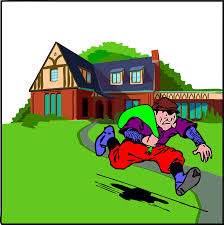
Durante è una preposizione usata per esprimere: “nel tempo in cui,
intanto che”. È seguita da un sostantivo:
- Durante dicembre, trascorriamo le vacanze natalizie con la famigli
a di mia sorella.
- Si sono annoiati durante il film.
- Sandro ha perso il posto durante la crisi economica.
- Molte persone innocenti sono morte durante la guerra.
................................................
What is the difference between the uses of “MENTRE” and “DURANTE”.
Here are a few examples:
Mentre is a conjunction used to express “at the time which, while”.
It is followed by a verb:
- While I was speaking, Luigi looked at me intently.
- The robbery happened while we were out of the house shopping.
- While Elena studies, she likes to listen to music.
- The encore occurred while you played your last ballad.
Durante is a preposition used to express: “at the time which, during”.
It is followed by a noun:
- During December, we spend our Christmas vacation with my
sister’s family.
- They got bored during the movie.
- Sandro lost his job during the economic crisis.
- Many innocent people died during the war.
|
Saturday, June 25, 2022
|
|
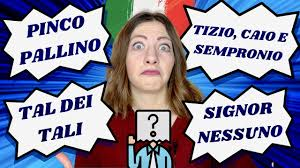
TIZIO, CAIO, E SEMPRONIO—Parte 2 =
Ulteriori informazioni da darvi su questo tema:
1. “Tizio” (preso da solo) rappresenta nel linguaggio comune il sinonimo
di “una persona qualsiasi”, “un tale”, tanto è vero che nel Dizionario della
lingua italiana si trovano anche le sue flessioni/declinazioni grammaticali:
maschile, femminile, singolare, plurale, ecc.
2. “Tizio, Caio e Sempronio”, viene personalizzato in alcune regioni
italiane. Nel dialetto napoletano, per esempio, il terzetto è stato tradotto in
“Mimì, Cocò, e Carmeno o’ pazzo”.
3. Tizio, Caio e Sempronio è anche il titolo di un film comico del 1951
ambientato ai tempi della Roma antica, in cui si racconta la vicenda di tre
personaggi immaginari e le loro peripezie, è scritto da Vittorio Metz e
Marcello Marchesi e diretto da Marcello Marchesi.
4. Pinco Pallino (o Pinco Pallo) è un nome di pura fantasia di uso
popolare e comune col quale si indica una persona o un'entità della quale non è
necessario conoscere caratteristiche specifiche. A volte assume carattere
spregiativo o ironico: si dice un pincopallino, per intendere un perfetto
sconosciuto e irrilevante. È spesso usato come sinonimo di qualcuno.
Il nome ha la stessa funzione di Tizio (a volte unito con Caio e
Sempronio) o Tal dei Tali o Signor Nessuno che a volte vengono preferiti a
Pinco Pallino.
TOM, DICK, AND HARRY—Part 2
More information to give you on this subject:
1. “Tizio” (used alone) in everyday language is the synonym for
“anyone”, “a guy”, so much so that in the Dictionary of the Italian Language
you find its grammatical variations/declensions: masculine, feminine, singular,
plural, etc.
2. “Tizio, Caio e Sempronio” is personalized in several regions of Italy.
In Neapolitan dialect for example, the trio becomes “Mimì, Cocò, and Carmen
the Crazy”.
3. Tizio, Caio and Sempronio is also the title of a comedy from 1951
set in ancient Rome, which talks about the adventures of three imaginary
characters. This film is written by Vittorio Metz and Marcello Marchesi, and
directed by Marcello Marchesi.
4. Pinco Pallino (or Pinco Pallo) is an invented name, commonly used to
indicate a person or entity for which the knowledge of specific characteristics is
not necessary. At times, it takes on disparaging or ironic meanings; you can
say a pincopallino to mean a perfect and irrelevant stranger. It is often used as
a synonym for someone.
The term has the same use as Tizio (at times combined with Caio and
Sempronio) or So and so, or Mr. Nobody, which at times are preferable to Pinco
Pallino.
Saturday, June 18, 2022
|
|
TIZIO, CAIO, E SEMPRONIO—Parte 1
 = =

TOM, DICK, AND HARRY—Part 1
Ci sono molti modi per esprimere CHIUNQUE in italiano:
Tal dei Tali
Signor Nessuno
Pinco Pallo
Pinco Pallino
o anche Mevio, Filano e Calpurnio,
ma i nomi più comuni sono: Tizio, Caio e Sempronio.
Qual è l’origine di questo sodalizio? Gli studiosi ci dicono che compaiono per la
prima volta riuniti nelle opere di Irnerio, giurista medievale italiano e uno dei
fondatori della Scuola di Diritto dell’Università di Bologna. Irnerio (c. 1050—
dopo il 1125) visse durante il periodo della fondazione dell’Università più antica
d’Europa nel 1088, e fu il primo ad adoperare l'unione classica: Titius, Gaius et
Sempronius. Le origini dei nomi non sono chiare, alcune sono attribuite alla
famiglia Gracco: Tizio derivato da Tiberio Gracco; Caio da Caio Gracco suo
fratello, e Sempronio da Sempronio Gracco, il loro padre. Ma abbiamo anche
Tito Flavio Vespasiano e Tito Livio, o la conoscenza che Gaio era un nome
comunemente usato dagli antichi romani. (Informazioni tratte dall’Accademia
della Crusca.)
Anche se non sappiamo di certo a chi attribuire la nostra triade, è molto più
elegante degli equivalenti in inglese: Tom, Dick and Harry, Average Joe,
Ordinary Joe, John Doe, Joe Sixpack, Ordinary or Average Jane, Jane Doe,
Jane Smith, John Q. Public, Joe Blow, Joe Schmoe, John Smith, Eddie
Punchclock, Joe Botts, J. S. Ragman, Vinnie Boombotz.
.....................................................
There are many ways to say ANYBODY or ANYONE in Italian:
So and So
Mr. Nobody
Pinco Pallo
Pinco Pallino
o even Mevio, Filano e Calpurnio.
However the most common names are: Tizio, Caio e Sempronio.
What is the origin of this association? Scholars tell us that they appear
together for the first time in the works of Irnerio, a medieval Italian jurist and
one of the founders of the School of Law at the University of Bologna. Irnerio
(c. 1050—d. after 1125) lived during the period of the establishment of the
oldest university in Europe in 1088, and was the first to use this classic union:
Titius, Gaius et Sempronius. The origins of the names are not clear, some are
attributed to the Gracco family: Tizio derived from Tiberius Gracco, Caio from
Caio Gracco, his brother and Sempronio from Sempronio Gracco, their father.
Yet we also have Tito Flavio Vespasiano and Tito Livio or the knowledge that
Gaio was one of the names commonly used in ancient Rome. (Information
taken from the Accademia della Crusca.)
Even if we don’t know for certain to whom we can attribute our triad, it is much
more elegant than the English equivalents: Tom, Dick and Harry, Average Joe,
Ordinary Joe, John Doe, Joe Sixpack, Ordinary or Average Jane, Jane Doe,
Jane Smith, John Q. Public, Joe Blow, Joe Schmoe, John Smith, Eddie
Punchclock, Joe Botts, J. S. Ragman, Vinnie Boombotz.
Saturday, June 11, 2022
|
|

Abbiamo esaminato la differenza tra MINESTRA, ZUPPA, MINESTRONE,
PASSATO, VELLUTATA e CREMA; non abbiamo dimenticato il BRODO! Ma il
MINESTRONE cos’è e come si prepara?
Il minestrone è un compromesso tra zuppa e minestra. È più denso di una
minestra e spesso viene arricchito con patate e legumi (come i fagioli) e pasta.
Ho trovato questo articolo interessante sul sito https://www.lacucinaitaliana.it:
I 5 comuni errori nel fare il minestrone:
1/5 Tagliare le verdure a caso. Tutto va tagliato allo stesso modo per rendere
la cottura uniforme.
2/5 Utilizzare verdure surgelate. Fatelo solo se non avete tempo di scegliere e
lavare le verdure fresche.
3/5 Insaporire con il dado. No: potete aggiungere erbe e spezie durante la
cottura. E poi le verdure sono già molto saporite.
4/5 Utilizzare verdure fuori stagione. Il cavolfiore e la zucca a giugno non
renderebbero speciale il vostro minestrone estivo. Anzi!
5/5 Non avere fantasia. Il minestrone non è mai un piatto triste perché può
essere arricchito in tanti modi. Aggiungete una fetta di pane croccante sul
fondo del piatto.
We have looked at the differences among MINESTRA, ZUPPA, MINESTRONE,
PASSATO, VELLUTATA and CREMA; we did not forget BROTH. However, what
is MINESTRONE and how is it prepared?
MINESTRONE is a compromise between zuppa and minestra. It is denser than
“minestra” and it is often enriched by the addition of potatoes and legumes
(like beans) and pasta.
I found this interesting article on the website https://www.lacucinaitaliana.it:
The 5 common errors in making minestrone:
1/5: Cutting vegetables willy-nilly. Everything should be cut in the same way
so the vegetables cook uniformly.
2/5: Using frozen vegetables. Use them only if you don’t have the time to
select and wash fresh vegetables.
3/5: Flavoring with a bouillon cube. Don’t: because you can add herbs and
spices during the cooking process. Besides, the vegetables are flavorful on their
own accord.
4/5: Using vegetables that are out of season. Using cauliflower and pumpkin in
June would not improve your summer minestrone, on the contrary!
5/5: Lacking imagination. Minestrone is never a sad dish because it can be
enriched in many ways. Add a slice of crusty bread on the bottom of the bowl.
Saturday, June 4, 2022
|
|
QUARTA PARTE (ovvero Brodo—parte #2)

Abbiamo esaminato le differenze tra MINESTRA, ZUPPA, MINESTRONE,
PASSATO, VELLUTATA, e CREMA ma manca il BRODO!
La volta scorsa abbiamo visto la spiegazione più breve della Garzanti
Linguistica e l’inizio della spiegazione più dettagliata dall’Enciclopedia
Treccani. Oggi continuiamo e finiamo quest’ultima voce.
3. Nell’industria, b. di ossa, soluzioni ottenute facendo bollire le ossa sgrassate
di animali (bovini, equini, ecc.) in autoclave con acqua; concentrati e lasciati
raffreddare, si rapprendono in masse gelatinose che, essiccate, costituiscono la
normale colla cervona o da falegnami.
4. In batteriologia, terreno liquido di coltura costituito essenzialmente da
infuso di carne o di particolari organi (b. al fegato), o contenente estratto di
carne (b. al Liebig).
5. In biologia, b. primordiale, espressione con cui, per traduz. dell’ingl.
primordial soup, vengono talora indicate le acque della Terra primitiva, ricche di
composti organici formatisi spontaneamente per effetto di fattori naturali
(radiazioni ultraviolette, scariche elettriche atmosferiche, gas vulcanici, ecc.),
dalle quali alcuni studiosi ritengono essersi originati i primi organismi viventi.
◆ Dim. brodino, un brodo leggero; spreg. brodùccio; pegg. brodàccio. Con
accezioni speciali il dim. brodétto (v.).
FOURTH PART (in other words Broth—part #2)
We have looked at the differences among MINESTRA, ZUPPA, MINESTRONE,
PASSATO, VELLUTATA and CREMA, but let’s not forget BROTH?
Last time we looked at the shorter explanation found in Garzanti Linguistica
and the first part of the much more detailed explanation from the Treccani
Encyclopedia. Today we continue and finish this last entry.
3. In the industry: bone broth, a solution derived from boiling animal bones
(beef, horse, etc.) in a pressure cooker with water; once they are cooled, the
form gelatins, that once dried, form the usual glue used by carpenters.
4. In the field of bacteriology, a liquid soil, usually infused with meat or organ
meat (liver broth), or containing meat extract (Liebid-style broth).
5. In biology, primordial broth, is an expression which is a translation from the
English primordial soup, used at times as referring to the waters of the
primitive Lands, rich in organic compounds, spontaneously created as the result
of natural factors (ultraviolet radiation, atmospheric electrical discharge,
volcanic gasses, etc.), from which several scientists believe the first living
organisms originated.
Diminutive: brodino is a light broth; disparaging term is brodùccio; and the
pejorative term is brodàccio. The diminutive term that is commonly accepted is
brodetto.
Saturday, May 28, 2022
|
|
Abbiamo esaminato la differenza tra MINESTRA, ZUPPA, MINESTRONE,
PASSATO, VELLUTATA e CREMA, ma non dimentichiamo il BRODO!
TERZA PARTE (ovvero Brodo—parte #1)

Siccome ho trovato due spiegazioni, una più breve e una più omplessa,
dividerò questa parte in due. La prima spiegazione ci viene da Garzanti
Linguistica:“BRODO: alimento liquido che si ottiene dalla lenta cottura in
acqua di carni o verdure con aggiunta di sale, aromi e spezie: brodo lungo,
ristretto; brodo di gallina, di manzo, di pesce; brodo vegetale, di dado;
pastina, tortellini in brodo |lasciar cuocere, lasciar bollire qualcuno nel
suo brodo, (fig.) lasciarlo fare a modo suo; non dargli consigli, non
impicciarsi |stare, starsene nel proprio brodo, (fig.) vivere appartato;
farsi gli affari propri |tutto fa brodo, (fig.) tutto
serve dim. brodino, vezz. broduccio, pegg. brodaccio
Etimologia: ← dal germ. *bròd.”
La seconda spiegazione molto più dettagliata proviene dall’Enciclopedia
Treccani: bròdo s. m. [dall’ant. alto ted. *brod (cfr. ingl. broth), da cui
anche broda].
1. Alimento liquido che si ottiene facendo bollire nell’acqua carne o vegeta
li con l’aggiunta di sale, aromi, spezie: b. di manzo, di pollo; riso, pastina
in b.; b. ristretto, fatto con carne cotta in poca acqua e quindi molto
sostanzioso (detto anche, con termine della cucina francese, consommé);
al contr., b. lungo, con molta acqua (e in senso fig., lunga chiacchierata, o
discorso, racconto, brano musicale lungo, prolisso, noioso; meno com.,
allungare il b., prolungare il discorso o la narrazione); b. vegetale,
ottenuto dalla lenta ebollizione di varî ortaggi, legumi, ecc.; b. finto,
ottenuto con estratto o con dadi. Nell’industria alimentare, b. concentrati,
a base di carne o di lievito, di composizione simileai corrispondenti estratti
ma con maggiore contenuto in acqua, cloruro sodico,eventualmente sostanze
grasse; dadi per brodo o per condimento, confezionati con estratti per brodo
essiccati, con aggiunta di sali, droghe, sostanzearomatizzanti, glutamato di
sodio, in percentuali variabili entro determinati
limiti.
2. Locuzioni fig.: essere un b., riferito all’acqua del mare, essere tiepida e
calma; lasciar cuocere o bollire nel proprio b., lasciare che altri faccia come
meglio crede, a suo modo; tutto fa b., tutto serve a qualcosa; andare
(o mandare) in b. di giuggiole (v. giuggiola); prov., gallina vecchia fa buon b., l
e cose vecchie hanno spesso maggior pregio e sono più utili (riferito talora
scherz. anche a persone).
Continueremo questa spiegazione la settimana prossima! Nel frattempo vi
auguro: BUON APPETITO!
THIRD PART (in other words Broth—part #1)
We have looked at the differences among MINESTRA, ZUPPA, MINESTRONE,
PASSATO, VELLUTATA and CREMA, but let’s not forget BROTH?
Since I found two explanations, one short the other more complex, I will divide
this section into two parts. The first explanation comes to us from Garzanti
Linguistica: ”BROTH” a liquid food derived from the slow cooking of meats or
vegetables in water with the addition of salt, herbs and spices; long broth,
concentrated chicken , beef, fish broth, vegetable broth from bouillon cube;
small pasta or tortellini in broth. Figuratively speaking: let someone cook/boil
in her/his own broth. Also figuratively speaking: live on one’s own; mind your
own business; everything makes a broth, everything is useful; diminutive:
brodino fake: broduccio; pejorative: brodaccio.
Etymology: from the German *brod.
The second explanation, which is much more detailed, is from the Treccani
Encyclopedia: Broth, singular masculine noun [comes from the ancient, high
German brod (broth in English) from which we also get the term broda.
1. A liquid food derived from boiling meat or vegetables in water with salt,
herbs, spices: beef or chicken broth; pasta in broth; concentrated broth, made
with meat cooked in a small quantity of water rendering it very nourishing (also
called consommé in France); on the other hand, long broth, is made with a lot
of water in a figurative sense, it means a long talk, discourse, tale, a long
piece of music, long winded, boring; less common is lengthen the broth which
means to prolong the talk or story); vegetable broth: obtained from the slow
cooking of various vegetables, legumes, etc.; fake broth, obtained from using
bouillon cubes.
In the food industry, concentrated broth, has as its base meat or yeast, it is
similar to corresponding extracts but with more water, sodium chloride, or other
fatty substances; bouillon for broth or seasoning, made from dried broth
extract, with the addition of salt, seasonings, herbs, sodium glutamate, in
various amounts.
2. Figurative expressions: to be a broth, refers to seawater, tepid and calm; let
cook or boil in one’s own broth, let others do what they believe is best, in their
own way; everything makes a broth, everything has a use; an old chicken
makes a good broth, old things often have a greater worth and are more useful
(at times, referring in a joking manner to persons).
We will continue this explanation next week, meanwhile I wish you BUON
APPETITO!
Saturday, May 21, 2022
|
|
Qual è la differenza tra MINESTRA, ZUPPA, MINESTRONE, PASSATO,
VELLUTATA e CREMA?
SECONDA PARTE 
Dividiamo la risposta in sezioni, e rispondiamo con l’aiuto del sito
https://www.lacucinaitaliana.it.
Spesso questi termini si usano come sinonimi ma minestra e minestrone, zuppa
e passato, crema e vellutata non sono la stessa cosa. La differenza? Tutta
negli ingredienti come pasta o cereali, e leganti come latticini o grassi. Si può
partire quindi dalle stesse verdure e declinarle in ognuna di queste versioni
rendendo il prodotto finale molto leggero, come in un passato o una minestra di
sole verdure verdi, o ricco e dall’alto valore nutritivo, tanto da essere
considerato un pasto completo. Ecco un piccolo dizionario tecnico - spesso
confutato dalle ricette regionali, che invece tradizionalmente usano nomi
differenti.
Vellutata
È composta solamente da 2, massimo 3, tipi di verdure come negli abbinamenti
tradizionali di patate-porri, zucchine-patate, carote-patate. Per legare gli
ingredienti e dargli una struttura più appetitosa e morbida, a fine cottura di
aggiunge panna da cucina o tuorli d’uovo.
Crema
Viene definita una preparazione con un solo ingrediente principale, frullato, e
legato da farina di riso o latte. Crema di riso, crema di zucchine, crema di
fagioli ecc...
Nel resto del mondo
Nel Regno Unito il chowder è quella zuppa consistente legata con farina e
arricchita di manzo, maiale o frutti di mare, negli States il chowder di mais è il
più popolare. Prende il nome dal recipiente in cui viene realizzato, il potage
francese, una minestra ricca, passata o a pezzi interi, mentre il consommé è un
brodo filtrato che può diventare doppio, cioè molto ristretto, e chiarificato con
albume d’uovo.
What is the difference among MINESTRA, ZUPPA, MINESTRONE, PASSATO,
VELLUTATA and CREMA? SECOND PART
After all, aren’t they all just soup? For now, we will divide the answer in
sections, with the help of the website
https://www.lacucinaitaliana.com/italian-food. [The translation into English is
theirs.]
We need to define our terms, so as not to confuse recipes that are very
different from each other. Whatever they are called, though, they will all be
good during the cold months or as a comfort food throughout the year.
Often these terms are used synonymously to describe a soup but minestra and
minestrone, zuppa and passato, crema and vellutata are not the same thing.
The difference resides in ingredients, like pasta or cereals, and thickeners such
as dairy products or fats. So you can start from the same vegetables and use
them in each of these versions, making the final product either very light, like a
passato or a minestra made only with green vegetables, or very rich and with a
high nutritional value, so much so that it’s considered a complete meal.
Here is a small technical dictionary – often refuted by regional recipes which
traditionally use different names.
Vellutata
It is composed only of 2, maximum 3, types of vegetables like in the traditional
combinations of potato-leek, zucchini-potato, carrot-potato. To bind the
ingredients and give it a more appetizing and soft texture, at the end of
cooking some cream or egg yolks are added.
Crema
It is preparation made with one main ingredient, pureed, and thickened with
rice flour or milk. Rice crema, zucchini crema, bean crema for example.
In the rest of the world
In the United Kingdom Chowder is a soup bound with flour and thickened with
beef, port or seafood, in the United States, corn chowder is the most popular.
The name comes from the container in which it is served; French potage is a
rich soup blended or in pieces, while consommé is a filtered broth which can be
doubled, meaning very concentrated, and clarified with egg whites.blog
Saturday, May 14, 2022
|
|
Qual è la differenza tra MINESTRA, ZUPPA, MINESTRONE, PASSATO,
VELLUTATA e CREMA?
PRIMA PARTE 
Dividiamo la risposta in sezioni, e rispondiamo con l’aiuto del sito
https://www.lacucinaitaliana.it.
Spesso questi termini si usano come sinonimi ma minestra e minestrone, zuppa
e passato, crema e vellutata non sono la stessa cosa. La differenza? Tutta
negli ingredienti come pasta o cereali, e leganti come latticini o grassi. Si può
partire quindi dalle stesse verdure e declinarle in ognuna di queste versioni
rendendo il prodotto finale molto leggero, come in un passato o una minestra di
sole verdure verdi, o ricco e dall’alto valore nutritivo, tanto da essere
considerato un pasto completo. Ecco un piccolo dizionario tecnico - spesso
confutato dalle ricette regionali, che invece tradizionalmente usano nomi
differenti.
Minestra
La minestra prende il suo nome da minestrare, amministrare, perché veniva
servita a tavola, ossia "ministrata", dal capofamiglia. Oltre alle solite verdure,
contiene cerali come riso, pasta, farro, orzo…. La minestra è più liquida, in
Lombardia viene preparata con l’aggiunta di riso, mentre nel Veneto e in Emilia
Romagna con pasta o cappelletti. I noodles cinesi o i ramen giapponesi sono
tecnicamente minestre.
Zuppa
Oltre alle verdure nella zuppa non compaiono mai riso o pasta, ma viene servita
solo, al massimo, con crostini di pane, più o meno grandi. Il suo nome è simile
in tutte le lingue europee, deriva dal gotico suppa, che indicava proprio la fetta
di pane che si usava mettere nelle ciotole prima di versarvi il brodo. La zuppa
ha un aspetto denso e consistente, viene utilizzata poca parte liquida,
assorbita da pane e crostini. La zuppa è molto diffusa in Toscana, con i cavoli
neri come verdura principale, in Calabria e Sicilia a base di legumi e fave, in
Sardegna, con l’irrinunciabile aggiunta di pezzetti di formaggio. Sono zuppe
anche il borsch di cavolo, la soupe à l'oignon o la soupe de poisson francesi.
Minestrone
Una via di mezzo fra zuppa e minestra, nato dopo la scoperta dell’America e
l’introduzione in cucina di alcuni ingredienti fondamentali come le patate, il
mais e i fagioli, che prima non esistevano nel “vecchio mondo”. Consistente e
ricco, al minestrone può anche essere aggiunto un cereale o della pasta – come
nel classico minestrone di legumi.
Passato
Un insieme di verdure, quindi la base per una zuppa o una minestra, senza
pasta o legumi o cereali, che viene frullato ad alta velocità. Un tempo si usava
il passaverdure a mano, e la sua consistenza era determinata dal tipo di maglie
attraverso cui si “passava” la verdura.
What is the difference among MINESTRA, ZUPPA, MINESTRONE, PASSATO,
VELLUTATA and CREMA? FIRST PART
After all, aren’t they all just soup? For the present, we will divide the answer in
sections, with the help of the website
https://www.lacucinaitaliana.com/italian-food. [The translation into English is
theirs.]
We need to define our terms, so as not to confuse recipes that are very
different from each other. Whatever they are called, though, they will all be
good during the cold months or as a comfort food throughout the year.
Often these terms are used synonymously to describe a soup but minestra and
minestrone, zuppa and passato, crema and vellutata are not the same thing.
The difference resides in the ingredients, like pasta o cereals, and thickeners
such as dairy products or fats. So, you can start from the same vegetables and
use them in each of these versions, making the final product either very light,
like a passato or a minestra made only with green vegetables, or very rich and
with a high nutritional value, so much so that it’s considered a complete meal.
Here is a small technical dictionary – often refuted by regional recipes which
traditionally use different names.
Minestra
The minestra takes its name from minestrare, to serve, because it was served
at the table by the head of the family. In addition to the usual vegetables, it
contains cereals such as rice, pasta, farro, barley... The minestra is rather
liquid, in Lombardy it is prepared with the addition of rice, while in Veneto and
in Emilia Romagna with pasta or cappelletti. Chinese noodles and Japanese
ramen technically fall into the minestra category.
Zuppa (soup)
In addition to vegetables, zuppa never includes rice or pasta. It is only served
with croutons, at most. Its name is similar in all European languages and
derives from the Gothic suppa, which indicated the slice of bread that was
placed in the bowls before pouring the soup. Zuppa has a dense and
substantial appearance, very little liquid is used, which gets absorbed by bread
and croutons. Zuppa is widespread in Tuscany, with collard greens or kale as
the main vegetable. In Calabria and Sicily it’s based on legumes and fava
beans. In Sardinia, it features bits of cheese.
Minestrone
A halfway point between zuppa and minestra, it was born after the discovery of
the Americas, with the introduction of some fundamental ingredients like
potatoes, corn and beans, which were previously unknown in the old world.
Substantial and rich, a cereal or pasta can also be added to the minestrone,
like in the classic legume version.
Passato
Passato is a vegetable soup, like a zuppa or a minestra, without pasta,
legumes, or cereals, which is blended at high speed. In the past, a food mill
was used and its consistency was determined by the type of mesh through
which the vegetables were milled.
Saturday, May 7, 2022
|
|
PLAY—Parte 2-SOSTANTIVI
Quando uno studente cerca nel vocabolario per la traduzione della parola “play”,
s’imbatte in una lunghissima lista di significati divisi tra sostantivi e verbi.
Continuiamo con i sostantivi: |
Ieri sera abbiamo visto uno spettacolo eccellente a teatro.
Che tipo di opera teatrale preferisci?
Non prendertela, era soltanto un gioco di parole!
Tocca a me, è il mio turno.
Il furto del capolavoro dal museo ha avuto molta attenzione nei giornali.
Ho guardato i riflessi dei raggi di luna sul laghetto.
Rosa non ha mai tempo per il divertimento, lavora e studia a tempo pieno.
Ricordatevi di premere il tasto play dopo aver inserito il CD.
Il calciatore ha eseguito una mossa straordinaria e ha fatto un gol.
  PLAY—Part 2-NOUNS PLAY—Part 2-NOUNS
When a student looks up the translation for the word “play” in the dictionary she
encounters a long list of meaning divided into nouns and verbs. Let’s continue
with nouns: |
Yesterday evening we saw an excellent play at the theatre.
What type of play (theatrical performance) do you prefer?
Don’t get upset, it was just a play on words!
It’s my turn, it’s my play.
The theft of the masterpiece from the museum received a lot of play in the
newspapers.
I watched the play of the moonbeams on the lake.
Rosa doesn’t have time to play, she studies and works fulltime.
Remember to press the play button after you have inserted the CD.
The soccer player executed an extraordinary play and scored a goal.
Saturday, April 23, 2022
|
|
 Pèsach o Pesah detta anche Pasqua Pèsach o Pesah detta anche Pasqua
ebraica, è una festività ebraica che dura otto giorni . Quest’anno inizia a
tramonto il 15 aprile.
Durante un corso che ho insegnato, abbiamo letto il romanzo di Giorgio Bassani
Il giardino dei Finzi-Contini e visto il film omonimo di Vittorio De Sica. Una
delle scene degna di ricordo è quella della famiglia seduta intorno al tavolo
dove celebrano la Pasqua ebraica e compartiscono la cena tradizionale, il Seder.
Nonostante le situazioni politiche che esistevano dopo l’emanazione delle Leggi
Razziali nel 1938, durante uno dei periodi più brutti della storia italiana, la fami
glia del protagonista Giorgio (non ha nome nel romanzo) canta una canzone
tradizionale e allegra.
È uso concludere il Seder cantando alcune poesie rituali, o piyutim. Sebbene il
Seder venga quasi sempre recitato interamente in ebraico, molte famiglie
ebraiche italiane usano cantare alcuni dei pyutim anche in italiano.
Ecco il pyut cantato dalla famiglia di Giorgio; e vi auguro BUONA PASQUA.
Chi sapesse chi intendesse
1. Uno – Dio è in cielo e uno fu, ed un è
2. Due – le tavole della legge,
3. Tre – padri nostri
4. Quattro – madri d'Israele
5. Cinque – i libri della Torah
6. Sei – tomi della Mishnà
7. Sette - giorni della settimana
8. Otto – giorni della Milah
9. Nove – mesi della partoriente
10. Dieci – sono i comandamenti
11. Undici – stelle risplendenti
12. Dodici – tribù d'Israel
13. Tredici – attributi di Dio
Pesach, Passover or even referred to as Jewish Easter, is a Jewish holiday
which lasts for eight days. This year it begins at sundown on April 15th.
During a class I taught recently, we read the novel by Giorgio Bassani The
Garden of the Finzi-Continis and saw the film with the same title directed by
Vittorio De Sica. One of the memorable scenes shows the family sitting around
the table where they are celebrating Passover with a Seder, the traditional
meal. Notwithstanding the political situations that existed after the passing of
the Racial Laws in 1938, during one of the ugliest periods of Italian history, the
family of the protagonist Giorgio (he doesn’t have a name in the novel) sings a
traditional and happy song.
It is common to end the Seder with traditional poems, piyutim. Although the
Seder is almost always spoken in Hebrew, many Italian Jewish families sing a
few pyutim in Italian.
Here is the pyut sung by Giorgio’s family; and I wish you a HAPPY
PASSOVER and a HAPPY EASTER.
Who would know, who would understand
1. One—God is in heaven, one his was, one he is
2. Two—the tables of the laws
3. Three—our fathers
4. Four—mothers of Israel
5. Five—books of the Torah
6. Six—volumes of the Mishnà
7. Seven—days of the week
8. Eight—days of Milah
9. Nine—months of she who is to give birth
10. Ten—are the commandments
11. Eleven—shining stars
12. Twelve—tribes of Israel
13. Thirteen—attributes of God
Saturday, April 16, 2022
|
|
 PLAY—Parte 1-VERBI PLAY—Parte 1-VERBI
Quando uno studente cerca nel vocabolario per la traduzione della parola
“play”, s’imbatte in una lunghissima lista di significati divisi tra sostantivi e
verbi. Iniziamo con i verbi:
I bambini giocano a calcio nel campetto qui vicino. (giocare)
A me piace giocare a bridge, ma tu preferisci gli scacchi. (giocare)
Il violoncellista suona nell’orchestra. (suonare)
Piacerebbe partecipare anche a Giacomo. (partecipare)
Anna Magnani ha recitato la parte di Pina in Roma città aperta di Roberto
Rossellini. (recitare)
Maddalena ha sempre voluto interpretare Mimì in La Bohème, e finalmente ce
l’ha fatta. (interpretare)
Chi impersona il ruolo di Rigoletto quest’anno? (impersonare)
Rappresentano “Sei personaggi in cerca d’autore” di Luigi Pirandello al Teatro
Centrale. (rappresentare)
Finalmente sono riuscito ad avere un ruolo in quel nuovo film che stanno
girando a Cinecittà. (avere)
Scusami, non volevo offenderti, stavo solo scherzando, mi dispiace.
(scherzare)
Sto facendo vedere il nuovo DVD ai miei amici. (far vedere)
Ti faccio ascoltare il nuovo concerto sinfonico. (far ascoltare)
When a student looks up the translation for the word “play” in the dictionary
she encounters a long list of meaning divided into nouns and verbs. Let’s
begin with verbs:
The children play soccer on the small sports grounds nearby.
I like to play bridge, but you prefer chess.
The cellist plays in the orchestra.
Even Giacomo would like to play.
Anna Magnani played the role of Pina in Roberto Rossellini’s film Rome, Open
City.
Maddalena always wanted to play the role of Mimì in La Boehme, and finally
she did it.
Who is playing the role of Rigoletto this year?
They are playing “Six Characters in Search of an Author” by Luigi Pirandello at
the Central Theatre.
I was finally able to play a role in that new movie they are filming at Cinecittà.
Forgive me, I didn’t mean to offend you, I was only playing around, I’m sorry.
I am playing the new DVD for my friends.
I will play the new concert for you.
Saturday, April 9, 2022
|
|
Le origini del pesce d'aprile non sono note con certezza. Una delle teorie più
accreditate spiega che prima dell'adozione del calendario Gregoriano nel 1582,
in Europa il Capodanno era celebrato dal 25 marzo (la vecchia data dell'equinozi
o di primavera) al 1° aprile. Nel 1564 il re francese, Carlo IX stabilì, con il
Decreto di Roussillon, che il primo giorno dell'anno sarebbe il 1° gennaio non
più il tradizionale giorno di Pasqua. Qualche anno dopo, la riforma di papa
Gregorio XIII avvalorò la festività di capodanno al 1º gennaio. La leggenda
vuole che molti francesi continuassero a scambiarsi regali, festeggiando il
Capodanno come ai vecchi tempi quando era d’abitudine farlo. Dei burloni
iniziarono a consegnare regali assurdi o vuoti durante questa festa di
capodanno primaverile ormai inesistente. Nel regalo vuoto si poteva trovare un
biglietto con scritto "poisson d'Avril": pesce d'aprile in francese.
In Italia l'usanza del 1° aprile è più recente: risale al 1860-1880. La prima città
ad accogliere l'abitudine francese è Genova. La tradizione si radicò prima tra i
ceti medio-alti, poi anche tra il resto della popolazione.
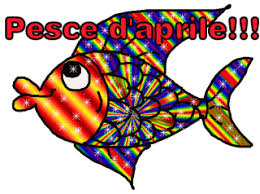
The origins of April fool’s Day are not known with certainty. The most common
theory explains that before the introduction of the Gregorian calendar in 1582,
New Year’s Day was celebrated in Europe between March 25th (the old date of
the vernal equinox) and April 1st. In 1564, the King of France Charles IX
established, with the Edict of Roussillon, that the first day of the year was to
be January 1st. A few years later, the reforms of Pope Gregory XIII confirmed
this date as January 1st. Legend states that many French women and men
continued to exchange gifts, celebrating New Year’s Day like in old times. Some
pranksters began to give absurd gifts or empty boxes during this now
nonexistent New Year’s springtime holiday. In the empty gifts, one could find a
note with the words "poisson d'Avril" in fact “the fish of April”; the French name
for April Fool’s Day (in Italian as well, Pesce d’aprile).
In Italy, the custom of April 1st is more recent; it dates to 1860-1880. Genova
was the first Italian city to accept this French habit. The tradition took root
firstly among the upper middleclass and then spread to the rest of the
population.
Saturday, April 2, 2022
|
|
VERBI DIFETTIVI—parte 4
Che cosa sono i verbi difettivi?
Secondo l’Enciclopedia Treccani, i verbi difettivi sono quelli mancanti di alcune
forme, tempi, modi e/o persone verbali. Ne rimangono pochi nell’italiano
contemporaneo; e per lo più si trovano soprattutto scritti e di registro alto.
Con questi verbi che seguono concludiamo la nostra lista tratta da varie risorse,
ricordiamo che sono, per la maggior parte, verbi poco utilizzati ma soddisfano
una curiosità grammaticale:
VIGERE: “essere in vigore”, “avere validità” …continuato:
Il verbo VIGERE è un intransitivo difettivo. Di solito, si usano le terze persone
singolari o plurali dell’indicativo presente e il participio presente. Del pari, sono
sempre stati senza participio passato verbi come àngere, compètere,
concèrnere, dirìmere, fèrvere, lùcere, mólcere, prostèrnere, prùdere, sùggere,
ùrgere (l’elenco non è ovviamente completo). Altri hanno invece (avuto) un
participio passato che oggi non è più usato (o raramente, in scritti perlopiù
letterari-poetici).
DEFECTIVE VERBS—part four

What are defective verbs?
According to the Encyclopedia Treccani, defective verbs are those missing some
form, time, mode and/or subject. Few remain in contemporary Italian; they are
predominantly found inwritten form and are more formal in nature.
With the verbs that follows we conclude our list taken from various sources;
keep in mind that for the most part these verbs are rarely used; however, they do
satisfy a grammatical curiosity.
VIGERE: “to be in vigor”; “to have validity”…continued:
VIGERE in an intransitive defective verb. Usually, these verbs use the third
person singular or plural of the present indicative and the present participle.
Similarly, the following verbs lack the past participle: àngere, compètere,
concèrnere, dirìmere, fèrvere, lùcere, mólcere, prostèrnere, prùdere, sùggere,
ùrgere
(Obviously, the list is not complete.) Other verbs on the other hand, have (or
have had) a past participle that is no longer used today (or rarely, for the most
part in literary-poetic writings).
Taken one at a time:
Angere (angosciare): to anguish/distress
Competere: to compete
Concernere: to have to do with
Dirimere: to bring an end to/to settle or resolve
Fervere: to boil over
Lucere: to shine
Molcere: to mollify
Prosternere: to prostrate
Prudere: to itch
Suggere: to suck
Urgere: to need
Saturday, March 26, 2022
|
|
| |
VERBI DIFETTIVI—parte 3 
Che cosa sono i verbi difettivi?
Secondo l’Enciclopedia Treccani, i verbi difettivi sono quelli mancanti di alcune
forme, tempi, modi e/o persone verbali. Ne rimangono pochi nell’italiano
contemporaneo; e per lo più si trovano soprattutto scritti e di registro alto.
Ciò che segue è una lista tratta da varie risorse, ricordiamo che sono, per la
maggior parte, verbi poco utilizzati ma soddisfano una curiosità grammaticale:
TANGERE: “toccare” in senso figurato, “interessare”. Si usano l’indicativo
presente (“tange”) e il participio presente (“tangente”).
SECERNERE: “produrre una sostanza organica”. Si usano: La terza persona
singolare e plurale dei tempi semplici (tranne il passato remoto); · Il participio
presente “secernente”; · Il gerundio presente “secernendo”; · Il participio
passato “secreto”.
SOLERE: “essere solito”, “avere l’abitudine”. Verbo di uso letterario, si usano:
· L’indicativo presente: “soglio”, “suoli”, “suole, “sogliamo”, “solete”,
“sogliono”; · L’imperfetto: “solevo”, “solevi” ecc.; · Il congiuntivo presente:
“soglia”, “sogliamo”, “sogliate”, “sogliano”; · Il congiuntivo imperfetto:
“solessi” ecc.; · Il participio passato: “sòlito”.
URGERE: “essere indispensabile”. Manca del participio passato e di
conseguenza dei tempi composti. Si usano: · La terza persona singolare e
plurale dei tempi semplici (tranne il passato remoto); · Il gerundio presente:
“urgendo”; · L’infinito: “urgere”.
VERTERE: “riguardare”. Manca il participio passato e di conseguenza i tempi
composti. Si usano: · Le terze persone singolare e plurale dei tempi semplici:
“vèrte”, “vèrtono”, “verteva”, “vertevano”, “verté”, “verterono” ecc.; · Il gerundio
presente: “vertendo”; · Il participio presente: “vertente”.
VIGERE: “essere in vigore”, “avere validità”. È difettivo del participio passato,
e quindi di tutti i tempi composti. Si usano: · La terza persona singolare e
plurale dell’indicativo presente: “vige”, “vigono”; · La terza persona singolare e
plurale dell’indicativo imperfetto (“vigeva”, “vigevano”) e dell’indicativo futuro
(“vigerà”, “vigeranno”); · Il gerundio presente: “vigendo”; · Il participio
presente: “vigente”.
DEFECTIVE VERBS—part 3
What are defective verbs?
According to the Encyclopedia Treccani, defective verbs are those missing some
form, time, mode and/or subject. Few remain in contemporary Italian; they are
predominantly found in written form and are more formal in nature.
What follows is a list taken from various sources; keep in mind that for the
most part these verbs are rarely used; however, they do satisfy a grammatical
curiosity.
TANGERE: “TO TOUCH” in a figurative sense, “to interest”. Only two forms are
used: the present indicative (“tange”) and the present participle (“tangente”).
SECERNERE: “TO PRODUCE AN ORGANIC SUBSTANCE”. It is used in the third
person singular and plural of the simple tenses (except for the past absolute);
the present participle “secernente”; the present gerund “secernendo”; the past
participle “secreto”.
SOLERE: “TO BE CUSTOMARY”, “to have the habit”. The verb has a literary use:
the present indicative is: “soglio”, “suoli”, “suole, “sogliamo”, “solete”,
“sogliono”; the imperfect is “solevo”, “solevi” etc.; the present subjunctive is:
“soglia”, “sogliamo”, “sogliate”, “sogliano”; the imperfect subjunctive is:
“solessi” etc.; and the past participle is: “sòlito”.
URGERE: “TO BE INDISPENSABLE”. The past participle is missing; therefore, it
lacks all compound tenses. This verb uses the third person singular and plural
in simple tenses (except the past absolute); it is also found in the present
form of the gerund: “urgendo”; and the infinitive: “urgere”.
VERTERE: “TO LOOK AT AGAIN/INSPECT”. The past participle is missing;
therefore, it lacks all compound tenses. This verb uses the third person singular
and plural in simple tenses: “vèrte”, “vèrtono”, “verteva”, “vertevano”, “verté”,
“verterono” etc.; it is also found in the present form of the gerund: “vertendo”;
and the past participle: “vertente”.
VIGERE: “TO BE IN VIGOR”; “TO HAVE VALIDITY”. The past participle is
defective; therefore, it lacks all compound tenses. This verb uses the third
person singular and plural of the present indicative: “vige”, “vigono”; the third
person singular and plural of the present imperfect (“vigeva”, “vigevano”) and
of the future indicative (“vigerà”, “vigeranno”); the present form of the gerund:
“vigendo”; and the present participle: “vigente”.
Saturday, March 19, 2022
|
|
ZIP 
Quante volte troviamo una parola introdotta da altre fonti quando l’italiano ha
già più di una espressione adeguata? Questo è successo con “zip”.
Si dice chiusura a lampo o cerniera, ma “zip” (femminile) è una parola molto più
economica!
Ho controllato l’Enciclopedia Treccani per la storia della zip:
“Un'idea lampo: Nel 1891, lo statunitense* Whitcomb Judson ideò un nuovo
sistema per allacciare le scarpe: la cerniera, cioè una serie di ganci metallici
chiusi automaticamente da un cursore. Brevettò la sua invenzione nel 1893, ma
essa non fu mai utilizzata perché era ancora troppo inaffidabile: bastava un
movimento brusco per farla aprire. Nel 1913 però l'invenzione fu perfezionata
da Gideon Sundback, un ingegnere anch'egli statunitense che riuscì a creare un
modello funzionale e affidabile, la cosiddetta cerniera lampo o, più brevemente,
zip.”
How often do we find a word introduced from other sources when Italian has m
ore than one perfectly adequate expressions? This occurred with “zipper”.
In Italian we say “chiusura a lampo” (lightning-fast closure) or “cerniera”, but
“zip” (a feminine noun) is so much more economical!
I checked the Encyclopedia Treccani for the history of the zipper:
“A lightning-fast idea: In 1891 Whitcomb Judson (from the United States)
devised a new system to tie shoes: the zipper, a series of metal hooks that are
automatically closed by a slider. He patented his invention in 1893, but it was
not used because it wasn’t reliable; all you needed was a sudden movement to
open it. In 1913 however, the invention was perfected by Gideon Sundback, an
American engineer who was able to create a functional and reliable model, the
lightning-fast closer, or briefly, the zip.”
*Please note that Italian actually has an adjective regarding the nationality of
someone from the United States, and it isn’t “American” it’s “Unitedstatesian”.
Saturday, March 12, 2022
|
|
VERBI DIFETTIVI—parte 2
Che cosa sono i verbi difettivi?
Secondo l’Enciclopedia Treccani, i verbi difettivi sono quelli mancanti di alcune
forme, tempi, modi e/o persone verbali. Ne rimangono pochi nell’italiano
contemporaneo; e per lo più si trovano soprattutto scritti e di registro alto.
Ciò che segue è una lista tratta da varie risorse, ricordiamo che sono, per la
maggior parte, verbi poco utilizzati ma soddisfano una curiosità grammaticale:
CONSTARE: “essere formati da”. Si usa solo alla terza persona.
CERNERE, COMPETERE, CONCERNERE, CONVERGERE, DELINQUERE, DIRIMERE,
DISCERNERE, DIVERGERE, ESIMERE, ESPANDERE, FERVERE, FULGERE,
FUNGERE, INCOMBERE, INDULGERE, SCERNERE, SPANDERE, STRIDERE,
SUGGERE: hanno tutte le voci con l’eccezione del participio passato, di
conseguenza non hanno i tempi composti;
FALLARE: nel participio passato fallato, per esempio: un vaso fallato, cioè
difettoso.
FERVERE: nelle forme ferve, fervono, ferveva, fervevano, fervente, spesso in
espressioni come fervono i preparativi, o un fervente cattolico.
MARCIRE: non si usano le forme “marciamo”, “marciate” perché coincidono con
quelle del verbo “marciare”. Per evitare possibilità di equivoci si ricorre al
verbo sinonimo “imputridire”.
OSTARE: rimasto solo nell’espressione burocratica null’osta “niente si oppone”.
PRUDERE: “dar prurito”. Mancando il participio passato mancano tutti i tempi
composti, ma viene poco usato anche il passato remoto.
DEFECTIVE VERBS—part 2

What are defective verbs?
According to the Encyclopedia Treccani, defective verbs are those missing
some form, time, mode and/or subject. Few remain in contemporary Italian;
they are predominantly found in written form and are more formal in nature.
What follows is a list taken from various sources; keep in mind that for the
most part these verbs are rarely used; however, they do satisfy a grammatical
curiosity.
CONSTARE: “TO BE FORMED BY”. Used only in the third person
CERNERE (to distinguish), COMPETERE (to compete), CONCERNERE (have to
do with), CONVERGERE (to converge), DELINQUERE (to commit a crime),
DIRIMERE (to bring an end to), DISCERNERE (to discern), DIVERGERE (to
diverge), ESIMERE (to exempt), ESPANDERE (to expand), FERVERE (to burn),
FULGERE (to glitter), FUNGERE (to function as), INCOMBERE (to threaten),
INDULGERE (to indulge), SCERNERE (to discern), SPANDERE (to spill/spread),
STRIDERE (to screech), SUGGERE (to suck): All these verbs can be found in all
the voices except the past participle, therefore, there are no compound tenses.
FALLARE: “TO ERR”. The past participle is fallato, for example: “un vaso
fallato”, a defective vase.
FERVERE: “TO BURN”: found in these forms: ferve, fervono, ferveva, fervevano,
fervente, often in expressions like ‘the preparations are in high gear; or a
fervent Catholic’.
MARCIRE: “TO ROT” this verb is not used in the forms of “marciamo”,
“marciate” (first and second person plural of the indicative) because they
coincide with the forms of the verb “TO MARCH”. In order to avoid any possible
misunderstanding, we use the synonym “imputridire” TO PUTREFY.
OSTARE: “TO OPPOSE” this verb is only found in the bureaucratic expression
null’osta “nothing is in opposition”.
PRUDERE: “TO ITCH”. Since the past participle is missing, there are no forms
in the compound tenses; additionally it is rarely used in the past absolute.
Saturday, March 5, 2022
|
|
VERBI DIFETTIVI—parte 1
Che cosa sono i verbi difettivi?
Secondo l’Enciclopedia Treccani, i verbi difettivi sono quelli mancanti di alcune
forme, tempi, modi e/o persone verbali. Ne rimangono pochi nell’italiano
contemporaneo; e per lo più si trovano soprattutto scritti e di registro alto.
Ciò che segue è una lista tratta da varie risorse, ricordiamo che sono, per la
maggior parte, verbi poco utilizzati ma soddisfano una curiosità grammaticale:
ADDIRSI: “convenire”, “adattarsi”. Si usa solo la terza persona singolare e
plurale dell’indicativo presente (si addice, si addicono) e imperfetto (si
addiceva, si addicevano) e del congiuntivo presente (si addica, si addicano) e
imperfetto (si addicesse, si addicessero). Il participio passato, “addetto”, si
usa solo come aggettivo o come sostantivo: per esempio “gli addetti” alla
sicurezza.
AGGRADARE: “piacere a qualcuno”. Si usa solo la terza persona singolare
dell’indicativo presente e spesso in senso ironico, “aggrada”.
ARDIRE: “osare”. [da non confondere col verbo “ardere”] non si usano le voci:
ardiamo, ardiate, ardente, ardendo che sono sostituite con il verbo “osare”.
ATTERRIRE: “spaventare”. Alcune voci sono sostituite col verbo spaventare per
non essere confuse col verbo “atterrare”.
AULIRE: “profumare”, di uso poetico. Si usa solitamente l’indicativo presente e
imperfetto e il participio presente.
CALERE: “interessare”. Si usa la terza persona singolare dell’indicativo
presente, “non mi cala”.
CONSUMERE: “consumare”, “logorare” (di uso letterario). Si usano l’indicativo
passato remoto (consunsi, consunse, consunsero) e il participio passato
(consunto) per esempio: il povero consunto vestito di casa.

DEFECTIVE VERBS—part 1
What are defective verbs?
According to the Encyclopedia Treccani, defective verbs are those missing some
form, time, mode and/or subject of a verb. Few remain in contemporary Italian,
and for the most part in written form and are more formal in nature.
What follows is a list taken from various sources; keep in mind that for the
most part they are rarely used verbs, however they do satisfy a grammatical
curiosity.
ADDIRSI: TO FIT, TO SUIT, TO BECOME “to be useful” “adapt”. It is used
only in the third person singular and plural of the present and imperfect
indicative (si addice, si addicono) (si addiceva, si addicevano) and the present
and imperfect subjunctive (si addica, si addicano) (si addicesse, si
addicessero). The past participle “addetto”, is used only as an adjective or a
noun, for example security guards. (gli addetti alla sicurezza).
AGGRADARE: “TO BE PLEASING”. It is used only in the third person singular of
the present indicative and often ironically.
ARDIRE: “TO DARE”. [Not to be confused with the verb “to burn”] the following
voices are not used because they are substituted by another verb, also
meaning “to dare”: ardiamo, ardiate, ardente, ardendo.
ATTERRIRE: “TO FRIGHTEN”. Several voices are substituted by the verb
“spaventare” to frighten, so as not to be confused with the verb “atterrare”
which means “to land”.
AULIRE: “TO PERFUME”, in a poetic sense. It is used only in the present
indicative and imperfect and in the present participle.
CALERE: “TO INTEREST”. It is used in the third person singular of the present
indicative, “it doesn’t interest me”.
CONSUMERE: “TO CONSUME”, “TO WEAR OUT” (literary use). The forms used
are the past absolute (consunsi, consunse, consunsero) and the past participle
(consunto) for example: the poor worn-out housedress.
Saturday, February 26, 2022
|
|
ALCUNI NOMI MASCHILI DA “P” a “A”: Parte 2
Succede a volte d’incontrare delle parole maschili che sono insolite
perché terminano in “a”. Ecco una lista di nomi maschili che
iniziano con la lettera “p” e terminano in “a” accompagnate dalle
loro traduzioni in inglese. La lista è sorprendentemente lunga.

SEVERAL MASCULINE WORDS FROM “P” to “A”: Part 2
At times, we encounter unusual masculine words because they end
in the letter “a”. Here is a list of masculine nouns that begin with
the letter “p” and end in “a” along with their English translation.
The list is surprisingly long.
| pentagramma |
musical staff/stave |
| pianeta |
planet |
| pigia pigia |
throng/dense crowd/crush |
| pigiama |
pajamas |
| pilota |
pilot |
| pirata |
pirate |
| plasma |
plasma |
| podestà |
chief magistrate |
| poema |
epic poem/symphonic poem |
| poeta |
poet |
| politeama |
politeama/multi-purpose theatre |
| portacipria |
compact for face powder |
| portafortuna |
good luck charm/talisman |
| prisma |
prism |
| problema |
problem |
| proclama |
proclamation |
| profeta |
prophet |
| programma |
program |
| promemoria |
reminder/memorandum |
Saturday, February 19, 2022
|
|
QUALCHE PROVERBIO PER IL GIORNO DI SAN VALENTINO:
L'amore è una scala sulla quale gli dei scendono fino a noi e noi ci
innalziamo
fino a loro.
Amore regge il suo regno senza spada.
Se il tuo bacio avrà l'ardore del sole, la rosa ti donerà tutto il suo
profumo.
L'amore vero non si vende e non si compra.
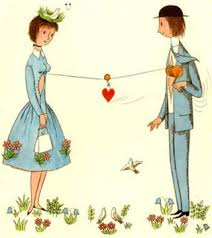
A FEW PROVERBS FOR SAINT VALENTINE’S DAY:
Love is a staircase on which the gods descend to us and we rise to them.
Love sustains its kingdom without a sword.
If your kiss has the sun’s ardor, the rose will give you all its perfume.
True love is neither bought nor sold.
Saturday, February 12, 2022
|
|
ALCUNI NOMI MASCHILI DA “P” a “A”: Parte I
Succede a volte d’incontrare delle parole maschili che sono insolite perché
terminano in “a”. Ecco una lista di nomi maschili che iniziano con la lettera “p”
e terminano in “a” accompagnate dalle loro traduzioni in inglese.
La lista è sorprendentemente lunga.
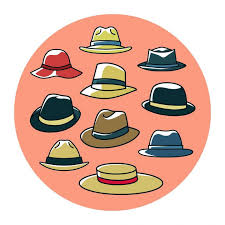
SEVERAL MASCULINE WORDS FROM “P” to “A”: Part I
At times, we encounter some unusual masculine words because they end in the
letter “a”. Here is a list of masculine nouns that begin with the letter “p” and
end in “a” along with their English translation.
The list is surprisingly long.
| Panama (il paese) |
Panama |
| panama (cappello) |
panama hat |
| panorama |
panorama |
| papà |
daddy |
| papa |
pope |
| parabrezza |
windshield |
| paracqua |
umbrella/rain cover |
| paradigma |
paradigm |
| parapiglia |
uproar |
| parapioggia |
umbrella/rain cover |
| parassita |
parasite/parasitic |
| pascià (dal turco "pashà") |
pasha |
| passamontagna |
balaclava/ski mask |
| patema |
worry/heartache |
| patriarca |
patriarch |
peana (Canto di vittoria;
all'origine in onore di Apollo) |
paean (Ode to victory; originally
in honor of Apollo) |
Saturday, February 05, 2022
|
|
ALCUNI NOMI MASCHILI IN –MA:
Succede a volte d’incontrare delle parole maschili che sono insolite perché
terminano in “a”. Ecco una lista di alcuni nomi maschili che terminano, in “ma”
accompagnati dalle loro traduzioni in inglese. Notate che a volte la traduzione è
identica all’originale.

SEVERAL MASCULINE WORDS THAT END IN “MA”:
At times, we encounter some unusual masculine words because they end in the
letter “a”. Here is a partial list of masculine nouns that end in “ma” along with
their English translation. Please note that at times the translation is identical
to the original.
| elettrocardiogramma |
electrocardiogram |
| ematòma (*) |
hematoma |
| emblèma |
emblem |
| encefalogr amma |
encephalogram (brain scan) |
| enfisema |
emphysema |
| enigma |
enigma, mystery |
| enzima |
enzyme |
| fantasma |
ghost |
| fibroma |
fibroma |
| fonèma |
phoneme |
| glaucòma |
glaucoma |
(*) Gli accenti sono solo per aiutarvi con la pronuncia. The accent marks are
merely to help you with pronunciation.
Saturday, January 29, 2022
|
|
Quando parliamo del tempo, in questo caso del clima, i verbi ai tempi
composti possono essere accompagnati da entrambi gli ausiliari: avere o
essere; il significato non cambia.
Nevicare:
Ha nevicato – è nevicato tutta la notte, ci siamo svegliati a un mondo
ammantato di bianco.
Piovere:
Ha piovuto – è piovuto per 40 giorni e 40 notti.
Grandinare:
Ha grandinato – è grandinato di colpo ieri, e ha ammaccato le automobili
chenon erano parcheggiate in garage.
Tuonare:
Ha tuonato – è tuonato così forte che mi sono svegliata durante la notte.
Ricordiamo che questi verbi sono usati solo alla terza persona singolare,
sono verbi impersonali.
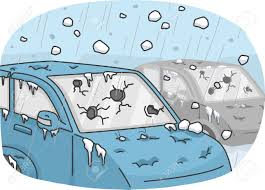
When we talk about “tempo” meaning weather or climate, the verbs in the
compound tenses can be accompanied by either of the auxiliaries “avere/to
have” or “essere/to be”, the meaning doesn’t change.
Nevicare – to snow
It snowed all night long, we awoke to a world mantled in white.
Piovere – to rain
It rained for 40 days and 40 nights.
Grandinare – to hail
It hailed suddenly yesterday, and it dented the cars that weren’t parked in the
garage.
Tuonare – to thunder
It thundered so loudly during the night that I woke up.
Be aware of the fact that the verbs expressing weather conditions in Italian
are only used in the third person singular, they are called impersonal verbs.
Saturday, January 22, 2022
|
|
| |
PIZZO 
Cosa significa “pizzo” e come si traduce in inglese?
1. Merletto o trina; per esempio, Il corpino dell’abito da sposa era ricoperto di
pizzo.
2. Barba tagliata a punta che ricopre solo il mento; chiamato anche pizzetto.
3. Cima aguzza o il picco di un monte; per esempio, Pizzo d’Ormèa in Piemonte.
4. Estremità appuntita di qualcosa, in particolare di un tessuto: per esempio, il
pizzo di un fazzoletto.
5. L’orlo o estremità; per esempio, Marta era seduta in pizzo sulla sua sedia.
6. Somma o tangente estorta da organizzazioni mafiose o criminali a
commercianti e imprenditori.
La parola è entrata nel lessico italiano nel 1885.

What does the word “pizzo” mean and how does it translate into English?
1. Lace; for example, The bodice of the wedding gown was covered in lace.
2. A pointed beard that covers only the chin, a goatee.
3. The pointed top of a mountain; for example, Pizzo d’Ormèa in Piedmont.
4. The pointed edge of something, in particular of fabric: for example, the edge
of a handkerchief.
5. The edge or outer limit; for example, Martha was seated at the edge of her
chair.
6. A sum of money or bribe extorted by criminal or mafia organizations from
shopkeepers or businesspersons.
This word entered the Italian lexicon in 1885.
Saturday, January 15, 2022
|
|
| |
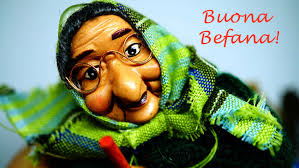
I found this interesting interpretation of the Befana on the website:
https://www.italyheritage.com/traditions/christmas/befana.htm
A non-conformist Befana
Alas, the picture of the benevolent old fairy has been fading away, year after
year, obscured by the myth of the "fat red-dressed laughing servant of
consumerism", and the children stare at a PlayStation screen and not at the
sky in search of the Befana.
Nowadays there is an amusing, non-conventional re-evaluation of the Befana:
"The Befana is Alternative because:
1- She is Ecological, since she travels on a broom
2- She is an Animalist, since she does not exploit poor reindeer
3- She is a Proletarian, since she dresses in non-fashionable clothes
4- She is a Justice Bearer, since she rewards only deserving ones
5- She is Tolerant, since her punishments are very mild, just ashes and coal
6- She is not Exacting, since in exchange for all her work she only takes some
bread soaked in wine or milk."
Ho trovato una interpretazione interessante riguardo alla Befana sul sito web:
https://www.italyheritage.com/traditions/christmas/befana.htm
La BEFANA non-conformista
Ahimè, l’immagine della fata benevola sta sparendo anno dopo anno, oscurata
dal mito del “servo del consumismo ridente, grasso e vestito di rosso”, e i
bambini guardano allo schermo del Playstation e non in cielo cercando la
Befana.
Oggigiorno c’è una rivalutazione divertente e non-convenzionale della Befana:
“La Befana è Alternativa perché:
1. È ecologica, siccome viaggia su una scopa
2. È animalista, siccome non sfrutta le renne
3. È proletaria, siccome indossa vestiti fuori moda
4. È portatrice di giustizia, siccome ricompensa solo i meritevoli
5. È tollerante, siccome le sue punizioni sono miti, solo ceneri e carbone
6. Non è esigente, siccome in scambio del suo lavoro prende solo del pane
inzuppato in vino o latte.”
Saturday, January 8, 2022
|
|

I wish you happiness in 2022 and thereafter.

Vi auguro felicità nel 2022 e oltre.
Saturday, January 1, 2022
|

|
|
|
|
|
